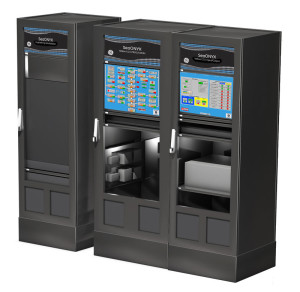GE unveils BOP surface control system, condition monitoring/sensing for subsea at OTC

A BOP surface control system and operator interface designed for deepwater drilling was among several technologies GE launched this week at the 2013 OTC. The Acoustic Leak Detection System and the Subsea Multi-domain Condition Monitoring System were two other technologies introduced at the Houston event.
The SeaONYX BOP surface control system from GE Oil & Gas incorporates the company’s Mark Vle hardware and Proficy software tools. It uses dual redundant electronic control systems to control the subsea equipment. The Mark VIe control components allows the SeaONYX to use a configuration that has been installed in more than 2,000 thermal, wind, hydro and nuclear facilities, according to GE.
“SeaONYX is a control system that helps to manage our BOPs in deepwater drilling operations. The development of the new system is an outstanding example of importing industry-leading technologies from other GE businesses into the oil and gass space,” said Chuck Chauviere, president of drilling for GE Oil & Gas. “In this case, our customers will be benefitting from a control system solution that has a strong track record of success and high-level performance in the global power generation industry.
A critical advance with the new control system’s Mark Vle control platform is its inherent design for obsolescence management. The system addresses the industrywide challenge of ensuring availability, especially for electronic components, for a product expected to operate for 20 years or longer. The SeaONYX system does this by using a standard footprint for the major components that will be used in future releases of Mark VIe hardware.
Another feature of the Mark Vle architecture is the ability to “hot swap” certain components while the system is running. When an individual component requires replacement, the rest of the system remains active while it is replaced. The new component will boot up, configure itself and typically come back online in a matter of minutes, increasing system availability.
The two condition monitoring and sensing solutions for the subsea sector, launched by GE’s Measurement and Control business, will allow operators to monitor the integrity of their subsea installation. The Acoustic Leak Detection System (ALD) uses passive, acoustic hydrophone technology to detect and locate subsea oil and gas leaks by discriminating the noise of a leak from other sources of sound. Developed from naval military technology, the system detects “silent” leaks that occur when there is low flow rate or low differential pressure.
The ALD can detect both crude oil and gas with a coverage up to 500 meters.
The Subsea Multi-Domain Condition Monitoring System combines electric emission monitoring and acoustic hydrophones designed for monitoring the operating condition of subsea machinery and processes — from pumps and valves to supporting infrastructure. Typically combined with ALD to detect subsea leakage, the system performs multi-domain analysis supported by proven pattern recognition and machine learning algorithms to identify and display subsea structure, machine and pipeline activities and anomalies.
“As subsea exploration and production becomes increasingly important globally, many customers are looking to expand these topside capabilities to the seabed,” said Jens Abrahamsen, Naxys business leader for GE Measurement & Control, a GE Oil & Gas division. GE acquired Naxys in 2012. “By combining subsea sensors and acoustic condition monitoring with existing GE technology, GE customers can expand their view into operations and make intelligent, critical decisions about their operations.”




